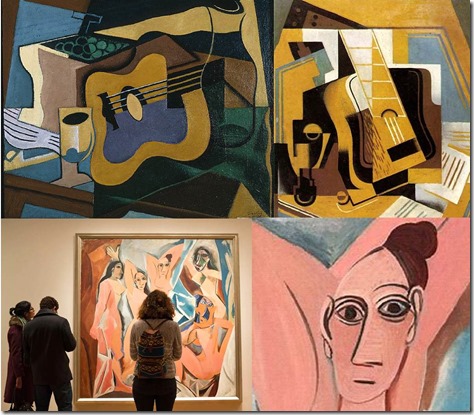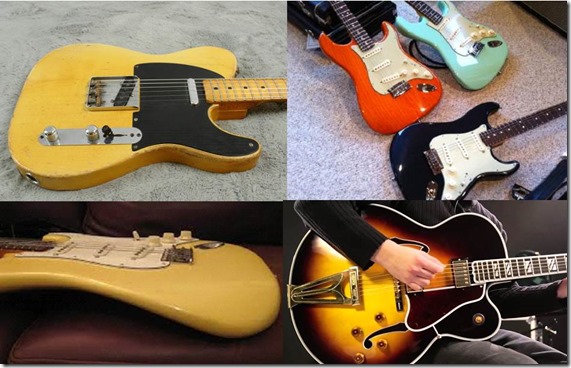Here’s a little story, about a one-eyed man named Leonidas, who you might think at first is not worthy of telling here at a place that talks about poetry and music. Was Leonidas an artist? Well, he started off an accountant. That’s important. Alas, the Great Depression happened, and even accountants were made redundant. Next, he opened a radio repair shop, since he’d been handy with electric circuits since he was a teenager. Better to repair a radio in those days, so he was able to make a go of that.
So, when does the art come in? Patience. Perhaps you know how revisions, pentimento, second drafts work in art? Then too, do you know the old saying about the one-eyed man in the kingdom of the blind.? That’ll apply too. There’s musical elements coming up, and we’ll end up in the Museum of Modern Art.
“No painters stroke…” Juan Gris’ fractured guitars. Picasso’s uncomfortable angled arms.
.
It wasn’t just families’ home entertainment radios that came into Leonidas’ shop. Musicians would come in and ask him to repair or construct public address systems. Leonidas’ region was bustling. First with agriculture, and soon with manufacturing. Workers wanted music at dancehalls, bars, and roadhouses, and the small affordable music combos with growing and sometimes rowdy audiences needed to be heard. Leonidas could make things loud.
Some of these musicians played electric guitars, a newish invention. The big hollow reverberant wooden boxes that had formerly needed only to be loud enough to provide a discreet chop of propulsion to large brass and saxophone led bands were now equipped with magnetic pickups which drove amplifiers so that one or two guitarists could replace that horn section. Simple accounting — the venues wouldn’t necessarily increase pay for larger, more elaborate groups. Slim down, but get louder.
One catch. The louder noise these big hollow guitars now made with pickups mounted on their surfaces reacted with a hellish howl from their resonate bodies’ underground cavities when the volume got loud enough. Leonidas’ amplifiers could make them loud, but the guitars couldn’t operate well in that loud environment.
Leonidas was the one-eyed man who knew nothing about guitars, but he’d been wiring electric pickups for a particular kind of electric guitar that was going through a bit of a fad: the “steel guitar.” A steel guitar wasn’t a guitar made out of steel, it was a simple flat piece of wood, like a small, narrow end table, with some strings and an electric guitar pickup that was played with a steel bar slid by one hand up and down the strings while the musician’s other hand plucks the notes the bar’s position has stopped on the length of the strings.
Leonidas got the notion to make a guitar that could be played in the regular way, with fingers fretting the notes, but still with a solid wooden body. He made a very practical instrument out of this idea. It was cheap to make, using inexpensive wood with an ingenious neck that could be removed in a minute with a screwdriver. Some musicians loved it, while guitar makers thought it crude. The simple plank of wood that made up a steel guitar wasn’t all that visible, being played flat like a table. This unadorned plank guitar was hardly more sophisticated, yet it would be hung around the musician’s neck for all to see. A musical end table is one thing, but hanging one around your neck while you sang or performed on stage? That’s just not right thought the existing guitar makers.*
Turns out musicians cared less about that incongruity, because Leonidas’ guitar was so practical, affordable, and it sounded great.
Soon other guitar makers responded to this success — but with fancier, less spartan iterations. The competitor’s responses might have golden paint or hardware and the same graceful arched tops the hollow guitars had, though now on top of solid bodies. Others had metalflake sparkle or fancy sunburst two-tone paint.
Leonidas may have been a non-guitar-playing accountant turned radio repairman, but he and his associates figured out how to fancy up his next design. The guitar he came up with next was curved and wrapped like a flowing scarf, shaped like an abstract painter’s asymmetric amoeba in the moment of forming itself into or away from the classical shape of a guitar. It would come in a variety of new-car-show colors. It had not just one, not just two, but three whole electric pickups. And it had a whammy bar, a spring-loaded vibrato device that let one easily swoop whole chords up and down in pitch. It was named like a Strategic Air Command bomber or the upper atmosphere verging on outer space: the Stratocaster.
Telecaster: like hanging an end-table around your neck and calling it a guitar vs. the colors and curves of the Stratocaster. A big Super 400 guitar forcing an arm akimbo.
.
Leonidas “Leo” Fender was born on this date in 1909. He never learned how to play the guitar — but he helped a whole lot of other people make music with one, by making his guitars affordable and durable like an accountant watching the logistical details. And as a repairman and tinkerer, he made his guitars easy to repair and modify. By choosing a modular design with interchangeable parts he made it possible for infinite variations of his original design to flourish. One could fill a store’s walls with a hundred variations of his Stratocaster — and eventually that is what happened. It’s the most popular electric guitar ever.
In 2015 while visiting New York I got to see them introduce a Stratocaster guitar into the Museum of Modern Art’s permanent collection. Thinking of the radio repairman’s art-shaped art-tool in the midst of MOMA’s paintings and sculptures I wrote this short ode to Leo’s Stratocaster in that context, and then I performed it with the LYL Band the same year. You can hear it below with the player gadget (where that’s seen) — or if you don’t see the gadget, with is highlighted link.
.
*Leonidas named this guitar that superseded his radio repairman line of work after the entertainment device that was obsoleting his radios, the Telecaster. I make the Telecaster sound crude because just like an Imagist poem that Modernists suggested could replace more elaborate and sufficiently “poetic” poetry, it did seem incomplete to many then. As an instrument however it’s surprisingly versatile to those who know their way around it. Despite the greater and continued popularity of the Stratocaster, there’s a solid cadre of players who give the secret handshake and declare “Leo got it right the first time.”


What an inspiring story. I never knew any of this. Thanks for sharing!
LikeLiked by 1 person